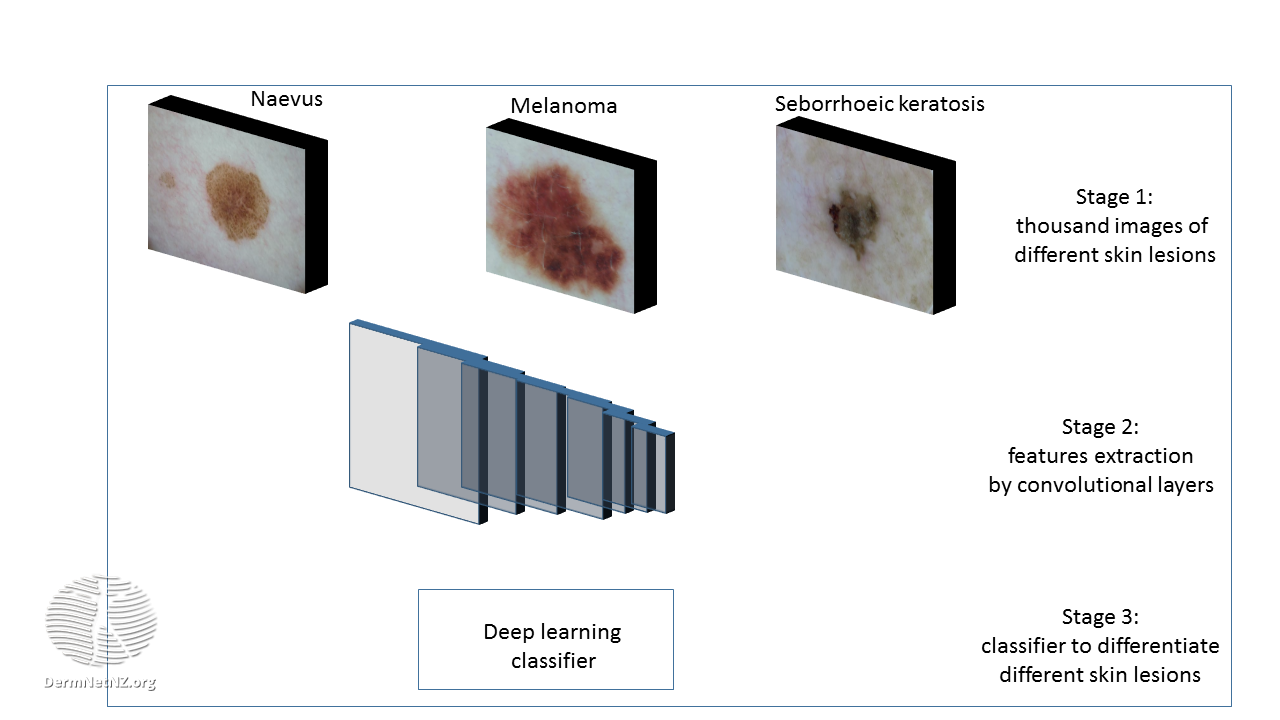- Acne
- Actinic Keratosis
- Aesthetics
- Alopecia
- Atopic Dermatitis
- Buy-and-Bill
- COVID-19
- Case-Based Roundtable
- Chronic Hand Eczema
- Chronic Spontaneous Urticaria
- Drug Watch
- Eczema
- General Dermatology
- Hidradenitis Suppurativa
- Melasma
- NP and PA
- Pediatric Dermatology
- Pigmentary Disorders
- Practice Management
- Precision Medicine and Biologics
- Prurigo Nodularis
- Psoriasis
- Psoriatic Arthritis
- Rare Disease
- Rosacea
- Skin Cancer
- Vitiligo
- Wound Care
Feature
Article
Skin Cancer Detection With AI: How Intelligent Is It?
Author(s):
With artificial intelligence taking front and center in many aspects of our lives, will it be more prevalent in the dermatology practice than it is now?
Overview of training of different types of skin lesions with the help of deep learning
Image courtesy of DermNet

Skin cancer is the most common cancer in the United States, with more than 9500 new cases diagnosed daily. One out of every 5 people is likely to develop a basal cell carcinoma (BCC), squamous cell carcinoma (SCC), or melanoma (or other types of skin cancer) before the age of 70. It is essential to catch skin cancers early to prevent disfigurement or loss of life. With artificial intelligence (AI) taking front and center in many aspects of our lives, will it be more prevalent in the dermatology practice than it is now? Will AI assist dermatology practitioners in detecting skin cancers earlier and faster than before? The answer is yes; ultimately, it will be a part of our future practice, but it is not ready yet.
Traditional methods of diagnosing skin cancer may be the approach of the past as AI tools providing assistance to the practitioner are becoming more prevalent. But how accurate are they? Will they cause any harm to the patient, and will insurance plans accept AI and even demand it? Ultimately, AI tools aim to aid in diagnosing skin cancer, including machine learning-based methodologies trained to detect and classify skin cancer using computer algorithms and deep neural networks.1 A recent analysis of AI based on a systematic review revealed the "robust potential of AI-based techniques to improve diagnostic accuracy and patient outcomes through the early identification of melanoma." The review also noted that "further studies are needed to assess the generalizability of these AI-based techniques across different populations and skin types, improve standardization in image processing, and further compare the performance of AI-based techniques with board-certified dermatologists to evaluate clinical applicability."2
Regarding AI, we as practitioners must ask ourselves, "How intelligent and accurate is it?" Many factors are necessary to develop a trusted AI source, beginning with the data's quality, the database's size, how it is annotated, who annotated the data, who trained the database, and whether bias of data or training was involved. Finally, what degree of transparency is available, and what confidence do we have in AI? "Machine learning and deep learning are branches of AI that deal with statistical modeling and inference, which progressively learn from data fed into them to predict desired objectives and characteristics."3
The following are known AI tools on the market:
- MelaFind was the first FDA-approved tool in 2011, but it is not available anymore. It was recalled in 2015 due to the device interface's lack of approval and the probability and histogram data within the MelaFind device.4
- DermaSensor’s FDA submission for approval is currently under review and not for sale in the United States. "DermaSensor is a handheld objective skin cancer sensing device that utilizes both pulses and light and spectroscopy to non-invasively identify information about a skin lesion at the subcellular level. More specifically, this device uses Elastic Scattering Spectroscopy (ESS), which measures and records photon scattering patterns as they reflect off different cellular structures following the input of quick bursts of light."5
- Nevisense is currently the only FDA-approved device on the market for the detection of melanoma. It uses Electrical Impedance Spectroscopy, which is "the spectrometric analysis of skin lesions, a computer software program is used that calculates and extracts information about the cells and structures of the skin. The method uses a light beam that penetrates beneath the skin surface. Light images taken with a digital camera or hand-held scanner are fed into a computer for detailed analysis."6
- Sklip is a US-based AI skin cancer triage algorithm developed by dermatologists. The Sklip dermoscopy algorithm (Sklip Mole Scanning Algorithm) received FDA Breakthrough Designation Status in 2021 and uses digital dermoscopy images and the dermoscopy 3-point checklist to flag skin lesions as suspicious. This software as a medical device (SaMD) has completed national clinical trials for its use in an intended professional setting with MD/DO/PA/NP healthcare providers.7
- MetaOptima is a Canadian-based AI skin cancer triage algorithm that received FDA Breakthrough Designation Status in 2021 and uses digital dermoscopy images for its analysis.8
- SkinAnalytics is currently approved in the UK and uses machine learning to recognize benign, premalignant, and the most common malignant lesions by capturing images from a system assessing over 70,000 NHS patients for suspicion of skin cancer.9
Ultimately, an excellent motto regarding AI is "garbage in, garbage out," considering the importance of supervised learning vs unsupervised learning and how it's reinforced when designing these tools. There are also many different approaches to developing these, such as the various learning models, which is another topic; however, it is crucial to consider when utilizing any AI tool.
Practitioners should move forward and demand more refined AI supervision by setting standards for its implementation. Strong government and company regulations are desperately needed to benefit the patient without causing harm. The good news is that the FDA strictly supervises skin cancer triage algorithms. It can be a powerful tool used in practice if done correctly. "Physicians should remain engaged in developing and deploying AI to allow this technology to reach its full potential.10 Dermatology practitioners should embark on AI in accepting the inevitable and embracing it as not a threat but an accessorial tool to aid in their diagnoses, not a stand-alone entity. "While considering the challenges of implementing end-to-end AI-based solutions in healthcare, there are many prospects, promises, and challenges."3
References
- Takiddin A, Schneider J, Yang Y, Abd-Alrazaq A, Househ M. Artificial intelligence for skin cancer detection: scoping review. J Med Internet Res. 2021 Nov 24;23(11):e22934. doi: 10.2196/22934.
- Patel RH, Foltz EA, Witkowski A, Ludzik J. Analysis of artificial intelligence-based approaches applied to non-invasive imaging for early detection of melanoma: a systematic review. Cancers (Basel). 2023 Sep 23;15(19):4694. doi: 10.3390/cancers15194694.
- Melarkode N, Srinivasan K, Qaisar SM, Plawiak P. AI-powered diagnosis of skin cancer: a contemporary review, open challenges and future research directions. Cancers (Basel). 2023 Feb 13;15(4):1183. doi: 10.3390/cancers15041183.
- Class 2 device recall MelaFind. US Food and Drug Administration. April 2, 2015. Accessed December 1, 2023. https://www.accessdata.fda.gov/scripts/cdrh/cfdocs/cfRES/res.cfm?id=136172
- Cuffari B. DermaSensors: the future of skin cancer detection. News Medical Life Sciences. Updated January 22, 2021. Accessed December 1, 2023. https://www.news-medical.net/life-sciences/DermaSensors-The-Future-of-Skin-Cancer-Detection.aspx#The%20Future%20of%20DermaSensor
- Ranaweera A. Electrical impedance spectroscopy for melanoma diagnosis. DermNet. June 2014. Accessed December 1, 2023. https://dermnetnz.org/topics/electrical-impedance-spectroscopy-for-melanoma-diagnosis#How%20Doeselectrical%20Impedance%20Spectroscopy%20Work?
- Sklip gets approval to test skin cancer triage at home with patients using artificial intelligence. News release. BusinessWire. September 8, 2022. Accessed December 1, 2023. https://www.businesswire.com/news/home/20220908005399/en/Sklip-Gets-Approval-To-Test-Skin-Cancer-Triage-At-Home-With-Patients-Using-Artificial-Intelligence
- Products. MetaOptima. Accessed December 1, 2023. https://www.metaoptima.com/
- AI pathways. Skin Analytics. Accessed December 1, 2023. https://skin-analytics.com/ai-pathways/
- Delving deeper into the potential of AI. News release. European Academy of Dermatology and Venereology. October 12, 2023. Accessed December 1, 2023. https://eadvcongress2023.org/wp-content/uploads/2023/10/EM012850_EADV_press_release_AI_skin_cancer.pdf
Newsletter
Like what you’re reading? Subscribe to Dermatology Times for weekly updates on therapies, innovations, and real-world practice tips.














